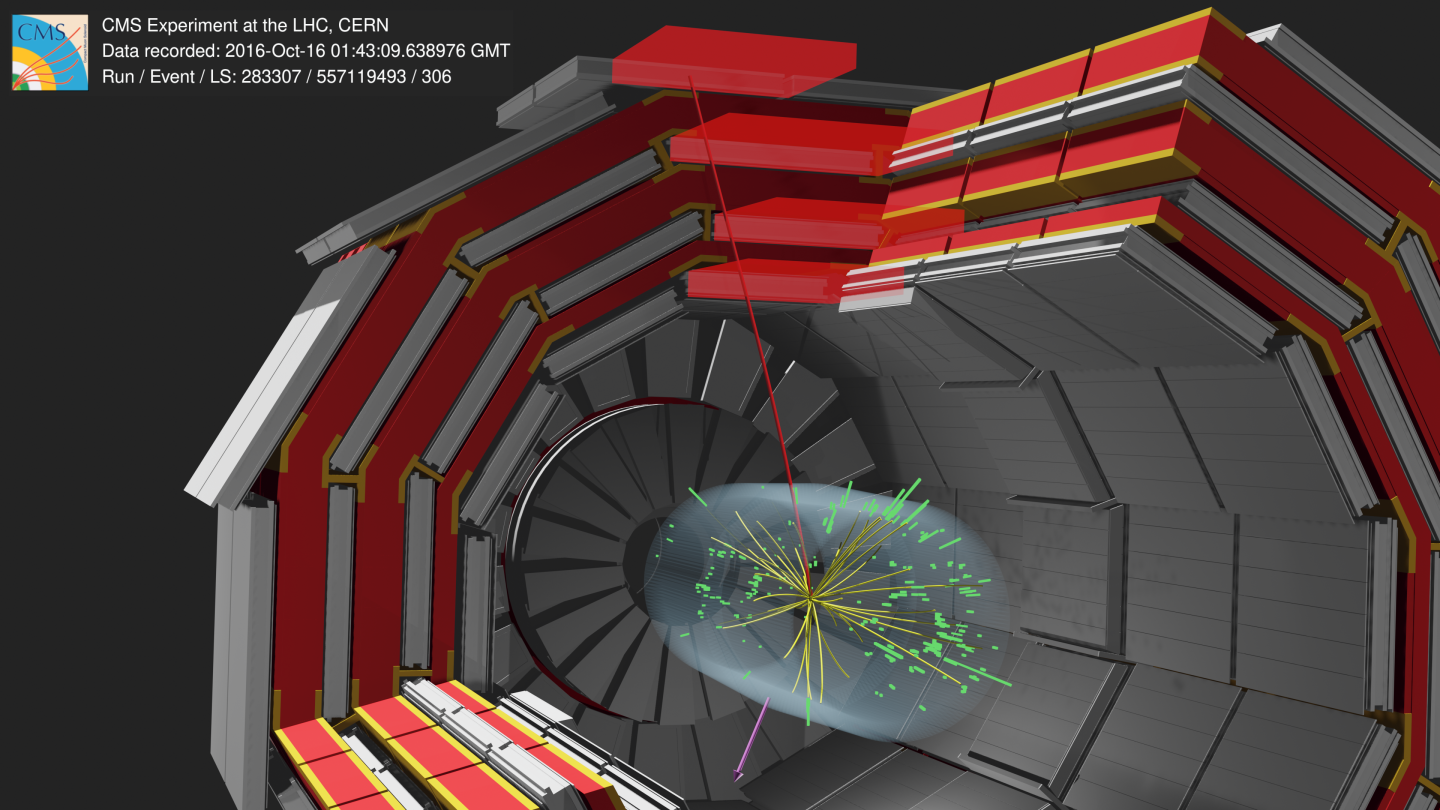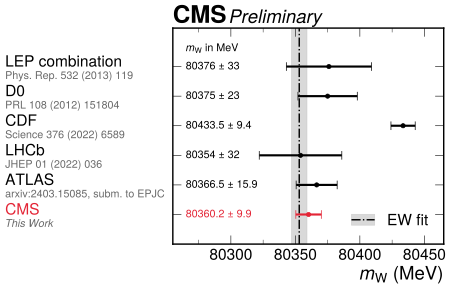
CMS candidate collision event for a W boson decaying into a muon (red line) and a neutrino that escapes detection (pink arrow). (Image: CMS/CERN)
The CMS experiment at CERN is the latest to weigh in on the mass of the W boson - an elementary particle that, along with the Z boson, mediates the weak force, which is responsible for a form of radioactivity and initiates the nuclear fusion reaction that powers the Sun.
At a seminar held at CERN today, the CMS collaboration reported how it has analysed proton-proton collision data from the second run of the Large Hadron Collider, the Laboratory's flagship particle accelerator, to make its first mass measurement of this fundamental particle.
The result is the most precise measurement of the W mass made so far at the LHC, and is in line with the prediction from the Standard Model of particle physics and with all previous measurements, except the measurement from the CDF experiment at the former proton-antiproton Tevatron collider at Fermilab.
In the Standard Model, the W mass is related closely to the strength of the interaction unifying the electromagnetic and weak forces and to the masses of the Higgs boson and the top quark, which constrain its value to 80353 million electronvolts (MeV) within an uncertainty of 6 MeV.
Measuring the W boson mass with high precision therefore makes it possible to test whether or not these properties all align in a way that is consistent with the Standard Model. If they don't, the cause could be new physics phenomena such as new particles or interactions.
Since its discovery at CERN about 40 years ago, the W boson has had its mass measured ever more precisely by several collider experiments, at CERN and elsewhere. In 2022, a surprisingly high value of its mass measured by the CDF experiment plunged the particle into a "midlife crisis". The CDF W boson mass, 80433.5 MeV with an uncertainty of 9.4 MeV, differed significantly from the Standard Model prediction and from the other experimental results, calling for more studies.
In 2023, the ATLAS collaboration, which provided its first W boson mass measurement in 2017, released an improved measurement based on a reanalysis of proton-proton collision data from the first run of the LHC. This improved result, 80366.5 MeV with an uncertainty of 15.9 MeV, lined up with all previous measurements except the CDF measurement, which remains the most precise to date, with a precision of 0.01%.
The CMS experiment has now contributed to this global endeavour with its first W boson mass measurement. The keenly anticipated result, 80360.2 with an uncertainty of 9.9 MeV, has a precision comparable to that of the CDF measurement and is in line with all previous measurements except the CDF result.
"The wait for the CMS result is now over. After carefully analysing data collected in 2016 and going through all the cross checks, the CMS W mass result is ready," says outgoing CMS spokesperson Patricia McBride. "This analysis is the first attempt to measure the W mass in the harsh collision environment of the second running period of the LHC. And all the hard work from the team has resulted in an extremely precise W mass measurement and the most precise measurement at the LHC."
"W mass measurements are very challenging, involving delicate measurements and theoretical modelling of the production of the W boson and its decay into a lepton (here, a muon) and a neutrino that escapes detection," explains incoming CMS spokesperson Gautier Hamel de Monchenault. "By exploiting the ability of the CMS detector to measure muons with high precision and using the latest and most advanced theoretical ingredients, some of which were tested by a cross-checking analysis, we attained this record level of precision."
The result showcases once again the exceptional performances of the LHC and its detectors, which continue to push the precision frontier and put the Standard Model and its extensions to ever more stringent tests. Further data from the ongoing third run of the collider and from its upgrade, the High-Luminosity LHC, is poised to push this frontier further.

Measurements of the W boson mass reported over the years by experiments worldwide. The CMS measurement is the most precise one made at the LHC so far, and has a precision comparable to that of the CDF measurement. (Image: CMS/CERN)






